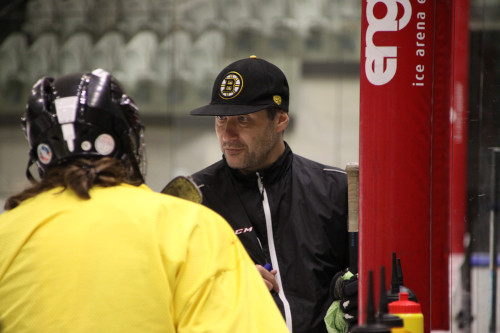Right or wrong? - Part 2 of an small, ex post series about my coaching philosophy and experiences
Decision Making
In the gleaming corridor of the 51st floor
The money can be made if you really want some more
Executive decision, a clinical precision
Jumping from the windows filled with indecision
Koka Kola - The Clash

How many decisions in our lives were wrong? What appears to be a tricky question, can IMHO be answered pretty easily. No decision can be wrong at the time taken. Why? Because at the very moment we take a decision, we take it based on our momentary perception and our personal life experience (which some would probably call ‘gut instinct’).
But, in hindsight, a lot of decisions seem wrong or at least subpar. Which does not contradict the above statement. Analyzing a decision’s impact often reveals the shortcomings based on new/additional findings. Still we can - and must - work on acquiring a factual basis that leads to a majority of decisions that stand the test of time. Remember? 8 out of 10 or so… Being able to do so is not just the basis for successful coaching, it’s a necessitiy as well in engineering, management (and life 😀).
So, for becoming a (yet more) successful coach / engineer / manager (read: human being) we have to ask ourselves, how to improve our decision making. My take on that has for a long time been based on the work (and words as laid out in his bio “iWoz”) of Steve Wozniak, genius co-founder of Apple. It’s much about…
Doing Things Right
So what? Isn’t taking the (in hindsight) right decision the same as doing things right? Not exactly. By doing things right we rather talk about a few main principles of successful and professional work:
- become an expert in what you’re doing; by improving your knowledge you not enlarge the amount of personal experience on a matter, but also improve your perception of a situation!
- avoid quick and dirty solutions whenever you can craft an (e.g. technically) immaculate work
- prepare for (foreseeable) future decisions
In short, _take your time!_ Remember, in the end it's the final outcome that defines the quality of your decisions, be it decisions in engineering, management or coaching, these rules are universal. So does this mean we need to be an expert on everything we do? Yes and no - in the end we have to acquire as much expertise in the fields as possible. Let me provide two examples from (very) different aspects of my life:
Example 1, Electronics Design:

I’ll start out with a task from my audio work - designing a simple, single tube based amplifier stage. Nowadays quite a few different approaches seem feasible to achieve the goals of minimum distortion and (probably) maximum amplification. Starting out with selecting an appropriate tube we can
- use the tube most designers would use in this case (aka “I’m a YouTube engineer”)
- use what we have (in times of supply shortage this might unfortunately make a lot of sense)
- use what we’re used to apply (“always done that”)
- or carefully read and analyze the documentation of a bunch of probably suitable devices.
Of course 4. (probably in combination with 2.) would be doing things right. But it takes time. A lot of time, as not only you have to do the actual work of digging through data sheets and engineering notes but even more you have already spent a lot of time acquiring the knowledge necessary to make use of this data (i.e. understand matters).
Once you’ve taken this first step the second one is the actual amplifier stage design. Static and dynamic operating conditions for optimum performance, quiescent current, power dissipation, headroom and a lot more has to be considered. And again quite a few different approaches might lead to the desired results:
- Trial and error: in former days this was cumbersome and expensive as it had to be done physically, building the stage, turning on power (short prayer before?), holding breath - if nothing exploded, test. Compare test results with expected results, change component values, start over again. Nowadays this sort of engineering(???) has become quite fashionable, as broad availability of simulation software significantly lowered the risks of this approach.
- Google and find someone else’s design (an accompanying YouTube video would be fine…)
- Use recommended designs from data sheets originating in the 1950’s
- Dig through the above mentioned data sheets, read/analyze the output curves, apply load lines, calculate all relevant parameters for all load lines and operating points selected. Compare all results. Probably use a spreadsheet to optimize.
I leave it to he reader to decide which of the above possibilities (or combinations thereof) complies with the doing things right paradigm. BTW: There exist certainly more possibilities than presented.
Example 2, Selecting a Hockey Drill for Practice:

When starting out as a coach I was searching for sources of useful hockey drills. Basically I looked for books, online ressources, but also tried to get in personal contact with other coaches to ask for advice (this is probably the right time to say a very big “thank you” to Jozef Hosmaj who most probably was the most important tutor I had in this respect. Jozef is certainly one of the best hockey coaches I’ve ever met. Moreover he’s the kind of friend you can always rely on. And the first thing he told me was sort of: “Everyone can go out and lead a practice. Select some suitable drills and let the players execute them. But this doesn’t mean you’re a good coach. Probably you’re not even a coach at all at this point”.
So what’s the point in this? It’s mainly (but not solely, see below) about communication. And it’s not just about knowledge of training methods, season and practice planning, drills, etc. All this is of course inevitable for any coach taking his/her business even fairly serious. So, what’s my take on that?
Consider planning to improve whatever aspect of your teams play. Depending on your backgruond and experience you might or might not have an appropriate drill at hand. If not, you search (books, online, …) or ask someone. But no matter how, in the end you have to ask yourself some Important questions:
- detailed purpose of the drill?
- do you really understand the original author’s intention?
- does it fit 100% into your game plan?
- detailed aspects of any part of the drill (skating, moves, paths) - if the drill ends with a shot, watch out for the shots, more often than not these are seen as the ‘nice to have’ part of a drill, especially in women’s hockey (with fatal consequences on the girls' shooting abilities)!
All this is time-consuming and can get quite laborious. And yet it’s just the beginning… After all the next step is to comminicate the drill to the team. Easy job, use markers on a coaching bord, some arrows here, some circles there, players nod their heads and off you go (and don’t forget the whistle 😈)…
Yikes, no. You will quickly realize the players excersise the drill, but it’s not at all what you’ve expected (ok, this might work with very simple drills). In general you will have to communicate all your above findings in detail to the players. At least inform about
- purpose of the drill
- how does it fit into the game plan
- which aspects should be improved
- crucial details
- eventual pitfalls (very important!).
So how can you be sure every player got the point and is now able to make the best out of the drill? This is probably the hardest part and cannot be achieved during one practice. This is a matter of trust. It’s your purpose as a coach to create a trustful team environment that allows players to ask questions (the more the better!) without feeling bad about it. Answer these question in detail, have patience, never get annoyed by these questions. Believe me, this is a success factor. It’s all about communication! The ability to communicate on eye level (something I learned in my early military service years, as well as in most of my industry and academic jobs) was by far my biggest asset when starting coaching - it virtually saved my life.
One might start wondering if all this takes some of the (often) precious on-ice practice time. Yes, it does. But in the end it pays back. Not only does the practice quality improve, at times you even need fewer repetitions of a certain drill since the explanation of well-known pitfalls prevents you from interrupting the drill to carve out some details done wrong. BTW, I do not really believe in explaining drills before practice (i.e. in the locker room) as is often taught in coaches education (again to save as much as possible of the precious on-ice time). The players simply forget about the details and practice quality declines. This does make sense for the on-ice warm up part of the practice (which is usually well-known to the players).
Summing up
Regrets, I’ve had a few
But then again, too few to mention
I did what I had to do
I saw it through without exemption
My way - Frank Sinatra (Paul Anka)
My way of doing things is what I tried to explain in the above paragraphs. My way of trying to do things right, actually. Do I always comply to thes rules? Of course not, as sometime I simply don’t find the time to do things the way they should be done. But, honestly, more often than not I had to regret not having taken the time to do things right.
Which finally leads me to sum up my approach in a short list:
1. Gather in-depth knowledge
2. Analyse in detail
3. Communicate
4. Apply
Sounds easy enough, was yet something I had to learn the hard way… 😳
More to come…